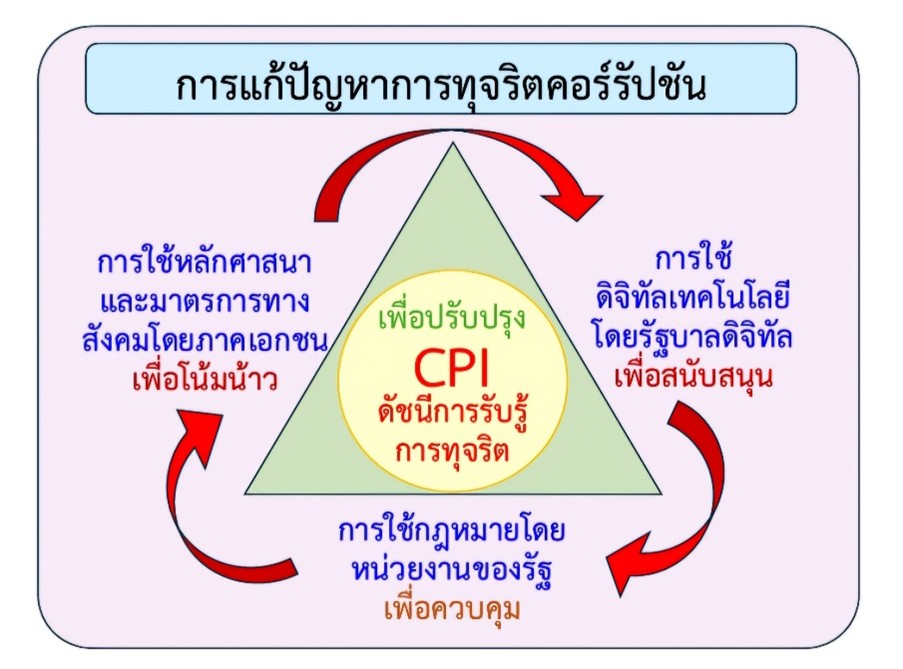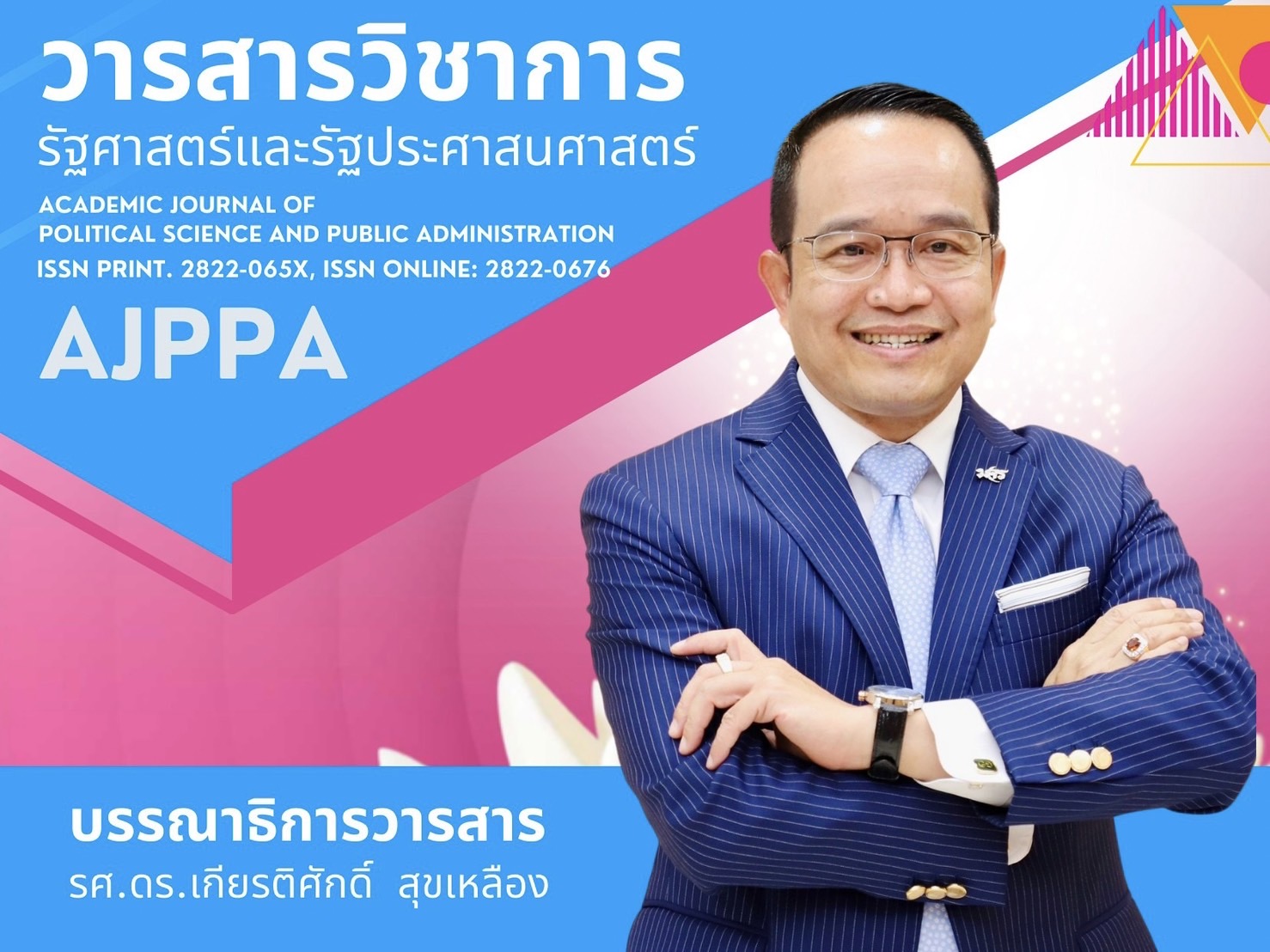CORRUPTION PERCEPTION INDEX REPORT 2024 AND SOLUTIONS TO THAILAND’S CORRUPTION PROBLEMS
Keywords:
Corruption Problem, Corruption Perception Index, Religious, Digital GovernmentAbstract
This academic article aims to present the current corruption situation in the Thai government sector by considering the Corruption Perception Index (CPI) value assessed by Transparency International (TI) annually. The latest announced is the result of the assessment in 2024. Thailand's score is 34 points, the lowest assessment score in over a decade. Thailand's score is lower than the world average and lower than the average of 10 ASEAN countries. Although Thailand has revised laws on corruption prevention and suppression, increased powers for inspection organizations, the public sector has formed associations and organizations to campaign against corruption, announced a National Strategic Plan, and planned to improve the government system to work quickly, transparently, and openly, and used digital technology to become a Digital Government, the assessment results did not improve. The author distinguishes that in improving the Corruption Perception Index, three main approaches have been taken: Approach 1: Enforcement of laws by the government sector; An independent organization has been established to review and improve laws that give agencies more power to investigate and punish corruption. The second approach in the private sector is to set up a network to investigate and campaign against corruption, using online media to disseminate news of corruption that the public has seen, and using religious principles to persuade senior government executives, civil servants, and the public to be honest. The third approach is to use digital technology to support and improve the work of the government sector in line with the policy of becoming a Digital Government so that the government system is fast, transparent, open, and verifiable. These three major measures will hopefully help improve Thailand’s CPI index.
References
ชิดตะวัน ชนะกุล. (2566). ประชาธิปไตยและการคอร์รัปชัน: กรณีศึกษาประเทศกลุ่มอาเซียน. Journal of Roi Kaensarn Academi, 8(3), 243-261.
ณัฐพัชกานต์ แก้วพลอย. (2562). หลักธรรมคำสอนพื้นฐานอิสลามกับการเรียนรู้เพื่อประกอบอาชีพการเลี้ยงปูดำขุนบริเวณป่าชายเลน อำเภอละงู จังหวัดสตูล. วารสารครุศาสตร์อุตสาหกรรม, 8(2), 236 -244.
ติรัส ตฤณเตชะ. (2566). วัฒนธรรมความไว้เนื้อเชื่อใจในสังคมเดนมาร์ก : หนทางสู่ความสำเร็จในการปลุกและปลูกจิตสำนึกต้านทุจริต. วารสารวิชาการ ป.ป.ช., 16(2), 85–102.
ธนพล เอกพจน์, วิรัช วงศ์ภินันท์วัฒนา, ปานปั้น ปลั่งเจริญศรี. (2566). การคอร์รัปชัน คือ โรคร้าย : อุปลักษณ์เชิงมโนทัศน์ของผู้ใช้ภาษาไทยในห้องสนทนาเกี่ยวกับการเมือง. วารสารนานาชาติ มหาวิทยาลัยขอนแก่น สาขามนุษยศาสตร์และสังคมศาสตร์, 13(3), 67-92.
ประกาศคณะกรรมการพัฒนารัฐบาลดิจิทัล เรื่อง แผนพัฒนารัฐบาลดิจิทัลของประเทศไทย พ.ศ. 2566 – 2570. (2566, 10 เมษายน). ราชกิจจานุเบกษา. เล่ม 140 ตอนพิเศษ 84. หน้า 1.
ประมวลจริยธรรมข้าราชการพลเรือน. (2564, 20 พฤษภาคม). ราชกิจจานุเบกษา. เล่ม 138 ตอนพิเศษ 109ง. หน้า 8-9.
พระราชบัญญัติมาตรฐานทางจริยธรรม พ.ศ.2562. (2562, 16 เมษายน). ราชกิจจานุเบกษา. เล่ม 136 ตอนที่ 50 ก. หน้า 1-10.
พระครูโอภาสนนทกิตติ์ (ศักดา โอภาโส). (2566). ทางออกการป้องกันและการปราบปรามทุจริตในสังคมไทย. วารสาร มจร สังคมศาสตร์ปริทรรศน์, 12(1), A114-A122.
พระพรหมคุณาภรณ์ (ป. อ. ปยุตฺโต). (2549). พระพุทธศาสนาพัฒนาคนและสังคม (พิมพ์ครั้งที่ 6). กรกฎาคม 2549. กรุงเทพฯ: โรงพิมพ์ บริษัท สหธรรมิก จำกัด.
พระพรหมบัณฑิต (ประยูร ธมฺมจิตฺโต). (2557). พุทธบูรณาการ เพื่อการพัฒนาจิตใจและสังคม. สรุปการประชุมวิชาการระดับชาติ มจร ครั้งที่ 1: Commemorative Book : MCU Congress I. พระนครศรีอยุธยา: มหาวิทยาลัยมหาจุฬาลงกรณราชวิทยาลัย.
พิเชฐ ทั่งโต. (2559). พุทธธรรมกับการป้องกันปัญหาการทุจริตคอร์รัปชันในสังคมไทย. วารสารจันทรเกษมสาร, 22(4), 1-15.
พิพิธภัณฑ์ต้านโกง. (2568). ดัชนีการรับรู้การทุจริต. สืบค้น 12 มกราคม 2568, จาก https://acm.nacc.go.th/press-release/cpi1.
พิษณุ หอมสมบัติ, พระปลัดภัครวัฒน์ สีลเตโช และสอาด ภูนาสรณ์. (2564). ฆราวาสธรรม 4 ประเภท: การป้องกันการทุจริตอย่างยั่งยืน. วารสารวิชาการธรรมทรรศน์, 21(2), 159-169.
พุทธทาสภิกขุ (เงื่อม อินฺทปญฺโญฃ). (2534). คู่มือมนุษย์ ฉบับสมบูรณ์ (พิมพ์ครั้งที่ 5). กรุงเทพฯ: สำนักพิมพ์ธรรมสภา.
วิไลพร อุ่นเจ้าบ้าน. (2560). พัฒนาการอธิบายความหมายของศีล 5. วารสารบัณฑิตศึกษามหาจุฬาขอนแก่น, 4(2), 1-15.
สมบัติ กองกะมุด. (2559). เบญจศีลในปรัชญาพุทธศาสนากับบัญญัติ 10 ประการ ในปรัชญาคริสตศาสนา : การศึกษาเชิงวิเคราะห์. วารสารพุทธมัคค์, 1(2), 25-32.
สำนักงานคณะกรรมการป้องกันและปราบปรามการทุจริตในภาครัฐ : ป.ป.ท.(2567). ดัชนีการรับรู้การทุจริตของประเทศต่าง ๆ ทั่วโลก (2024). สืบค้น 25 กุมภาพันธ์ 2568, จาก https://www.pacc.go.th/page1(2017).html.
สำนักงานคณะกรรมการป้องกันและปราบปรามการทุจริตแห่งชาติ : ป.ป.ช. (2567). รายงานประจำปี 2567. สืบค้น 25 ธันวาคม 2567, จาก https://rb.gy/jijm26.
สำนักงานคณะกรรมการป้องกันและปราบปรามการทุจริตแห่งชาติ: ป.ป.ช. (2568). ป.ป.ช. เผยผลวิเคราะห์ CPI 2567. สืบค้น 6 มีนาคม 2568, จาก https://shorturl.at/c8N82
อรุณัฐ ปุณยกนก. (2567). แผนพัฒนารัฐบาลดิจิทัลของประเทศไทย: การประยุกต์หลักพุทธธรรมเพื่อความสำเร็จ. วารสารบัณฑิตศึกษาวิชาการ, 2(4), 42-49.
ไอริน โรจน์รักษ์. (2564). จาก Estonia สู่ E-Estonia: ถอดบทเรียน 30 ปีธรรมาภิบาลกับการปฏิรูปภาครัฐ. วารสารมนุษยศาสตร์และสังคมศาสตร์นายเรืออากาศ, 9(1), (161-174).
Transparency International. (2024). Home/About. สืบค้น 26 ธันวาคม 2567, จากhttps://www.transparency.org/en/about.
______. (2025). Corruption Perceptions Index 2024. สืบค้น 6 มีนาคม 2568, จาก https://www.transparency.org/en/cpi/2024/index/sgp.

Downloads
Published
How to Cite
Issue
Section
Categories
License
Copyright (c) 2025 Academic Journal of Political Science and Public Administration

This work is licensed under a Creative Commons Attribution-NonCommercial-NoDerivatives 4.0 International License.



